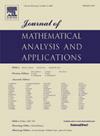Hopf bifurcation in a time-delayed multi-group SIR epidemic model for population behavior change
IF 1.2
3区 数学
Q1 MATHEMATICS
Journal of Mathematical Analysis and Applications
Pub Date : 2025-09-11
DOI:10.1016/j.jmaa.2025.130061
引用次数: 0
Abstract
In this study, we construct a time-delayed multi-group SIR epidemic model to discuss the impact of population behavior change on the occurrence of recurrent epidemic waves. We obtain the basic reproduction number and show that if , then the disease-free equilibrium is globally asymptotically stable, whereas if , then the disease-free equilibrium is unstable and an endemic equilibrium exists. In a special two-group case, we show sufficient conditions for Hopf bifurcation and obtain index values that determine the direction, stability and period of bifurcated periodic solutions. By numerical simulation, we investigate the occurrence of periodic solutions in two groups representing an urban area and a non-urban area. We conclude that the epidemic size, response intensity of population behavior change and heterogeneity in two different groups can be the key factors of the occurrence of recurrent epidemic waves.
考虑群体行为变化的时滞多群体SIR流行病模型的Hopf分岔
在本研究中,我们构建了一个时滞的多群体SIR流行病模型来讨论人群行为变化对反复流行波发生的影响。我们得到了基本繁殖数R0,并证明如果R0≤1,则无病平衡是全局渐近稳定的,如果R0>;1,则无病平衡是不稳定的,存在一个地方性平衡。在一个特殊的两群情况下,给出了Hopf分岔的充分条件,得到了决定分岔周期解的方向、稳定性和周期的指标值。通过数值模拟,我们研究了在代表城市区域和非城市区域的两组中周期解的出现。我们认为,疫情规模、人群行为变化的反应强度和两组人群的异质性可能是反复流行波发生的关键因素。
本文章由计算机程序翻译,如有差异,请以英文原文为准。
求助全文
约1分钟内获得全文
求助全文
来源期刊
CiteScore
2.50
自引率
7.70%
发文量
790
审稿时长
6 months
期刊介绍:
The Journal of Mathematical Analysis and Applications presents papers that treat mathematical analysis and its numerous applications. The journal emphasizes articles devoted to the mathematical treatment of questions arising in physics, chemistry, biology, and engineering, particularly those that stress analytical aspects and novel problems and their solutions.
Papers are sought which employ one or more of the following areas of classical analysis:
• Analytic number theory
• Functional analysis and operator theory
• Real and harmonic analysis
• Complex analysis
• Numerical analysis
• Applied mathematics
• Partial differential equations
• Dynamical systems
• Control and Optimization
• Probability
• Mathematical biology
• Combinatorics
• Mathematical physics.

 求助内容:
求助内容: 应助结果提醒方式:
应助结果提醒方式:


